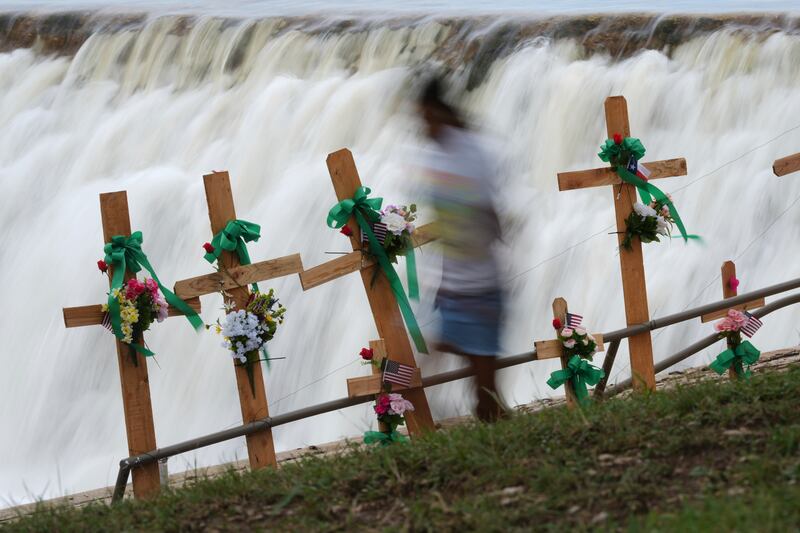- 135 people have been confirmed dead after the July 4 floods in Texas' Hill Country, officials said.
- State and local officials have worked to verify who is still missing and who is safe.
- It is common in large natural disasters for the missing person count to be a lot higher than the death toll.
Over the weekend, officials in Texas announced that the number of people missing following the July 4 floods had dropped from over 100 to three.
As is the case during major natural disasters, the number of people missing can often change dramatically due to a number of factors. Here’s a look at how the number of missing dropped so drastically:
Updated death toll and number of persons still missing
In the wake of the floods that ravaged Texas’ Hill Country over the July 4 weekend at least 135 people have been confirmed dead, per CNN.
In Kerr County alone there were 107 people killed, including 37 children.
There were initially 161 reported people missing in Kerr County, that number has now dropped to three, per NBC.
How did the number of missing drop so drastically?
This drastic drop in the number of missing was not completely unexpected, according to The New York Times.
In the chaos and confusion caused by a major disaster there is a lot of painstaking work required to bring clarity to the number of people missing. Making sense of the list of those unaccounted for is a crucial part of disaster response, whether for flash floods, tornadoes or wildfires.
A number of factors can play into the struggle of obtaining an accurate missing persons count, including tourists or visitors in the area and people without stable housing, per The Washington Post.
“This process takes time,” officer Jonathan Lamb of the Kerrville Police Department said in a statement on Sunday, per The New York Times. “It is essential to ensure that every lead is thoroughly followed and each person is properly accounted for.”
In major disasters people often report their loved ones missing if they haven’t heard from them. For the Texas floods this was further complicated because of the number of tourists who were in the area, these people’s family and friends were contacting officials from afar.
In order to clarify who was actually missing, state and local officials worked to verify the status of each individual who had been reported missing, per The New York Times.
Many people who had initially been reported as missing were verified as safe then were removed from the list, per BBC.
Kerrville City Manager Dalton Rice said it required “countless hours of coordinated search and rescue operations, careful investigative work, and an unwavering commitment to bringing clarity and hope to families,” per BBC.
Similar things have happened in past major disasters
It is not unusual for a large drop in the number of missing people to occur in the aftermath of a major disaster.
According to The New York Times, after the 2018 wildfire that devastated Paradise, California, there was a missing person count of 1,300. In the end, the final death toll was 85.
In Maui, Hawaii after the 2023 fire, there were 1,100 people reported missing, six months after the disaster there were 102 confirmed deaths with two people still missing.
In the aftermath of the Maui fire, the missing person count fell to 388 and authorities released a list of names. There were people who were surprised to find themselves on the list, per The New York Times.
When reflecting on his experience in the Paradise Fire, Butte County Sheriff Kory L. Honea said “People always want to draw a correlation between the number of people that haven’t been accounted for and the number of deaths,” per The New York Times.
It is not fair to come to that conclusion too early, he added.
The work isn’t over
Though officials in Kerr County acknowledged relief due to the steep decline in people missing, Lamb said the work is not complete, per The New York Times.
There are still three people missing, and their loved ones are still waiting.
In a Facebook post from Kerrville City, the mayor, Joe Herring Jr., said “Our thoughts remain with the families still awaiting news, and we will continue to stand with them as efforts persist.”
Weeks of search and rescue operations
Search and rescue operations in the areas devastated by floods have continued for over two weeks now and have included over 1,000 local, state and federal responders, according to The Washington Post. There have also been thousands of volunteers involved in combing through the area.
The search involved heavy equipment, search dogs, helicopters and waterborne teams. Firefighters and divers working from airboats and inflated zodiacs have searched through the murky waters of the Guadalupe River.
Some teams have also used sonar equipment to find out what might be buried in the riverbed, per The Washington Post.
Texas legislature special session
The Texas State Legislature on Monday started a special session and some of the agenda items include issues identified in the aftermath of the devastating floods.
“We delivered on historic legislation in the 89th Regular Legislative Session that will benefit Texans for generations to come,” said Gov. Greg Abbott, in a statement about the session. “There is more work to be done, particularly in the aftermath of the devastating floods in the Texas Hill Country. We must ensure better preparation for such events in the future.”
The state’s lawmakers will be working on legislation to improve warning systems and emergency communications, especially in flood prone areas, as well as legislation to provide relief funding for those affected by the floods, per CNN.
They will also focus on “legislation to evaluate and streamline rules and regulations to speed preparedness for and recovery from natural disasters,” per Abbott’s statement.


